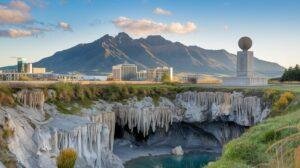Planning your first trip to the Great Barrier Reef? Wondering how to make the most of this natural wonder? Look no further! The Great Barrier Reef is a top spot in Travel Australia. It’s perfect for those who love nature and adventure. The vibrant marine life and stunning coral formations make it unforgettable.
Whether you’re into snorkeling or diving, this guide has you covered. We’ll share key info to plan your dream trip. You’ll learn about the unique ecosystem, the best times to visit, and how to make your first visit extraordinary.
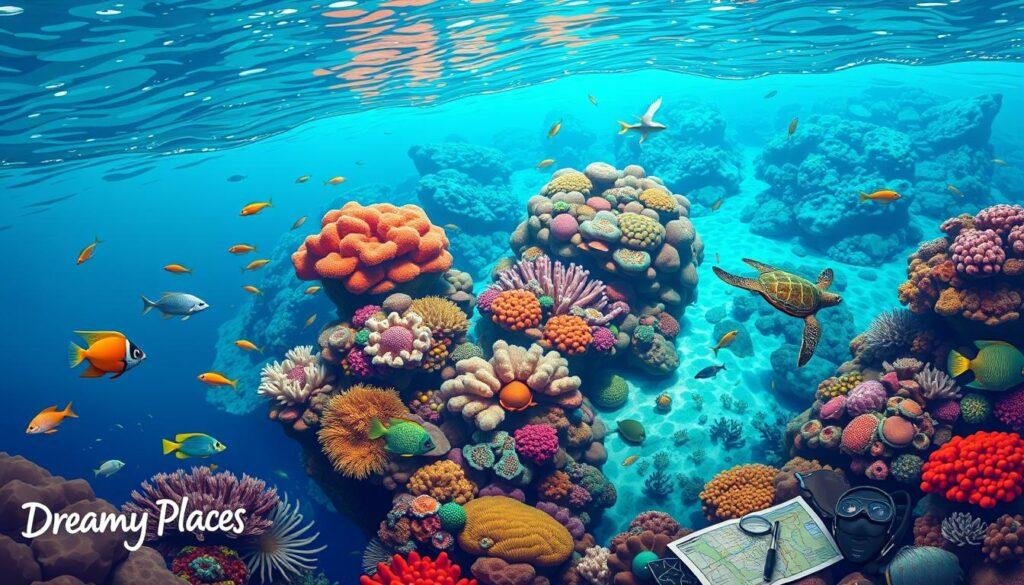
Key Takeaways
- Discover the diverse marine life and ecosystems of the Great Barrier Reef
- Learn about the best times to visit and the factors to consider when planning your trip
- Understand the importance of responsible tourism and reef conservation
- Prepare with the right gear and equipment for a comfortable and safe exploration
- Choose the perfect tour operator to make the most of your Great Barrier Reef adventure
Understanding the Great Barrier Reef’s Unique Ecosystem
The exploring great barrier reef is a natural wonder that showcases the remarkable diversity of marine life. This vast ecosystem is home to an array of vibrant corals, colorful fish, and a myriad of other fascinating creatures. As a great barrier reef for beginners, it’s essential to understand the unique features that make this region so special.
Marine Life You’ll Encounter
The exploring great barrier reef is teeming with an incredible variety of marine life. From the iconic clownfish and sea turtles to the elusive reef sharks and majestic manta rays, the diversity of species is truly astounding. Visitors can also spot a range of other marine creatures, including anemones, starfish, and a wide array of tropical fish in their natural habitats.
Reef Conservation and Responsible Tourism
The great barrier reef for beginners is a delicate and fragile ecosystem that requires careful stewardship. Responsible tourism practices are crucial in ensuring the long-term preservation of this natural wonder. Visitors are encouraged to follow eco-friendly guidelines, such as avoiding touching or standing on the corals, and properly disposing of any waste.
Different Reef Zones and Their Features
The exploring great barrier reef is composed of several distinct zones, each with its own unique features and marine life. The outer reef, for instance, is known for its dramatic drop-offs and abundant pelagic species, while the inner reef is characterized by its shallower waters and diverse coral formations. Understanding the different zones can enhance your appreciation for the reef’s intricate ecosystems and help you plan your exploration accordingly.
Exploring the great barrier reef for beginners is a truly remarkable experience, offering visitors a glimpse into the wonders of the underwater world. By understanding the reef’s unique ecosystem, marine life, and conservation efforts, you can fully immerse yourself in this natural marvel and contribute to its preservation for generations to come.
Best Time to Visit the Great Barrier Reef
Many dream of exploring the Great Barrier Reef. The right time to visit can make your trip unforgettable. Whether you want to dive, snorkel, or see marine life, knowing the seasons and weather is key.
The best time to visit the Great Barrier Reef depends on what you want to do. For diving and snorkeling, April to November is best. You’ll see clear waters, calm seas, and comfortable weather. This time, you can see colorful fish, turtles, and maybe a whale shark.
| Season | Weather Conditions | Best Activities |
|---|---|---|
| Dry Season (May-October) | Milder temperatures, lower rainfall, calmer seas | Diving, snorkeling, coral viewing |
| Wet Season (November-April) | Warmer temperatures, higher rainfall, potential for cyclones | Wildlife viewing, island hopping |
Keep in mind the peak tourist seasons during school holidays and summer. These times have more people and higher prices. For a quieter visit, go in April-May or September-November.
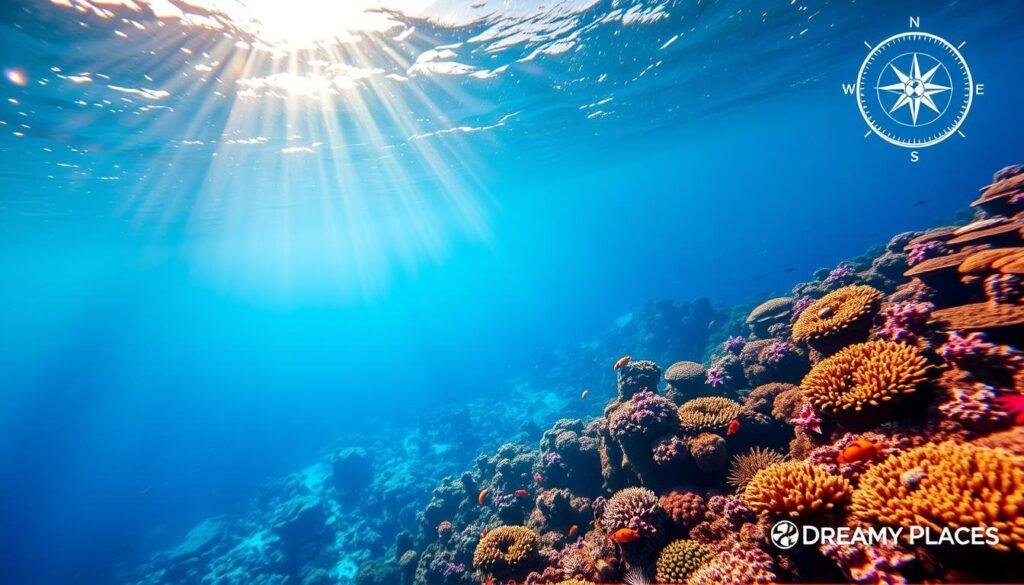
It’s important to know about weather hazards like cyclones and jellyfish. Always listen to local advice and tour operators. With good planning, your Great Barrier Reef trip will be amazing.
Planning Your Travel Australia Adventure to the Reef
Traveling to the great barrier reef travel guide is exciting for many. To enjoy your trip, planning is key. We’ll cover transportation, accommodation, and more for your great barrier reef travel guide.
Getting to the Great Barrier Reef
There are many ways to get to the great barrier reef travel guide. Flying into Cairns or Hamilton Island is the best. Then, take a boat or flight to your reef spot.
Choosing Your Base Location
The great barrier reef travel guide runs along Australia’s northeast coast. Cairns is lively, Port Douglas is calm, and the Whitsundays are beautiful. Each offers a unique experience.
Accommodation Options Near the Reef
For your great barrier reef travel guide, many places to stay are available. You can choose from fancy resorts to cozy homes. Think about how close it is to the reef and what’s nearby.
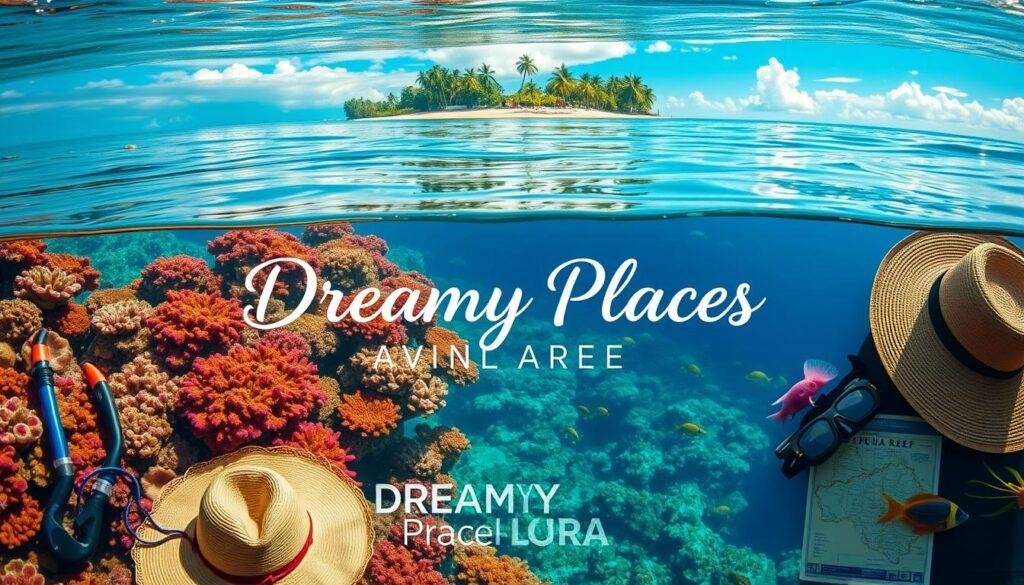
Plan well for your Travel Australia trip to the great barrier reef travel guide. This way, you’ll have a great time exploring this amazing place.
Essential Gear and Equipment for Reef Exploration
Exploring the great barrier reef needs special gear for a safe and fun trip. Whether you’re snorkeling or diving, the right equipment is key. It helps you dive deep into the reef’s wonders.
For a great great barrier reef for beginners trip, don’t forget these must-haves:
- High-quality snorkeling or diving mask, fins, and snorkel
- Wetsuit or rash guard to protect against the elements
- Waterproof camera and underwater housing to capture your memories
- Sun protection, including a wide-brimmed hat, sunglasses, and high-SPF sunscreen
- Water shoes or reef-safe sandals to protect your feet
- Lightweight, quick-drying clothing for on-land activities
- A waterproof bag or dry sack to keep your belongings safe and dry
You can rent or buy these items at your great barrier reef spot. But, it’s wise to check with your tour operator or hotel first. This way, you can plan better.
“The great barrier reef is a natural wonder that demands respect and care. Equipping yourself with the right gear is essential for ensuring a safe and sustainable adventure.”
With the right gear and preparation, you’ll enjoy the exploring great barrier reef experience fully. You’ll make memories that will last forever.

Choosing the Right Tour Operator
Planning your first-time visit to the Great Barrier Reef is exciting but can feel overwhelming. Choosing the right tour operator is key to a memorable and safe trip. There are many options, so it’s important to research and pick a reputable one.
Day Trips vs. Extended Tours
Deciding between a day trip or an extended tour is your first step. Day trips are great for those short on time or wanting a quick taste of the reef. Extended tours let you explore more, see remote spots, and really get to know the great barrier reef tips.
What to Look for in a Tour Package
- Safety measures: Make sure the tour operator follows strict safety rules. They should have the right gear and staff to keep you safe.
- Eco-friendly practices: Choose operators that care about the reef and use sustainable methods. This helps protect the delicate ecosystem.
- Value for money: Compare different tours to find one that’s worth your money. Look for good activities, amenities, and value.
By carefully choosing your tour operator, you can make the most of your first-time visiting great barrier reef trip. You’ll create memories that last a lifetime.
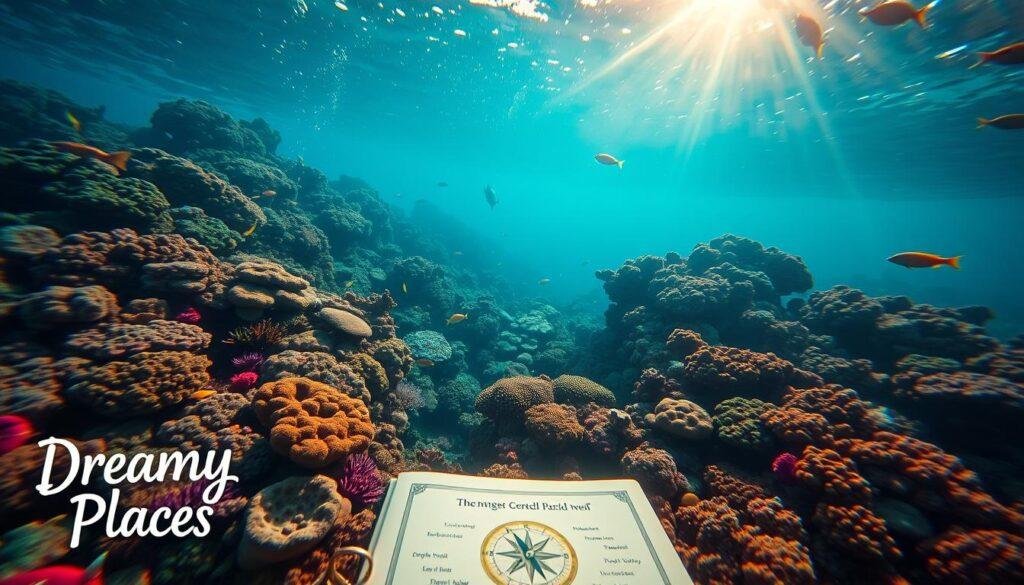
| Day Trips | Extended Tours |
|---|---|
| Ideal for limited time | Allows for deeper exploration |
| Provides a taste of the reef | Visits remote reef locations |
| Typically shorter in duration | Offers a more immersive experience |
Snorkeling and Diving Basics for Beginners
Exploring the snorkeling in great barrier reef and diving at the great barrier reef for beginners is thrilling. It’s key to know the basics before diving into the underwater world. We’ll cover essential skills and safety tips to enhance your reef adventure.
Snorkeling Essentials
Snorkeling lets you see vibrant marine life and coral up close. You’ll need a mask, snorkel, and fins. Make sure your mask fits well to keep water out. Practice breathing through the snorkel before you dive.
Diving for Beginners
Scuba diving offers a deeper experience. It needs special training and gear. Start with a beginner’s diving course to learn important skills like equalizing pressure.
Whether snorkeling or diving, respect the reef’s ecosystem. Don’t touch the coral or stand on it. Be careful with your movements to protect marine life.
Safety First
Your safety is most important. Listen to your tour guides and watch the weather and water. If you’re unsure, ask for help.
Knowing the basics and being responsible will make your adventure unforgettable. Get ready to explore the great barrier reef for beginners and enjoy the snorkeling in great barrier reef!
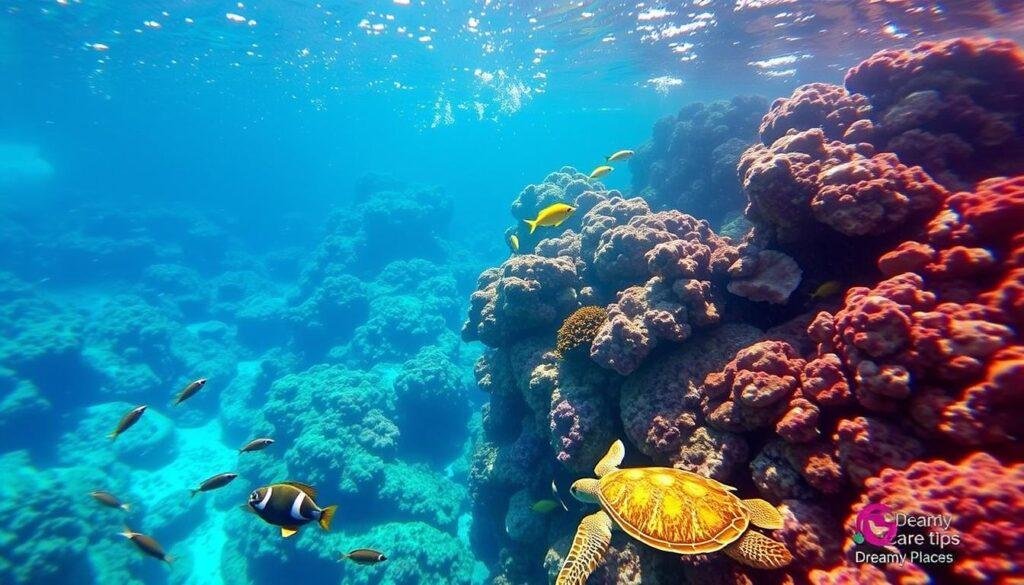
Safety Guidelines and Weather Considerations
Exploring the great barrier reef is an unforgettable adventure. But, it’s crucial to prioritize your safety. Knowing the weather and potential marine hazards is key to a safe and enjoyable great barrier reef travel guide.
Understanding Weather Patterns
The great barrier reef has a tropical climate all year. But, the weather changes with the seasons. The wet season (December to April) brings heavy rains and strong winds.
These conditions can make travel plans hard and diving or snorkeling tough. The dry season (May to November) is calmer and clearer, perfect for exploring the reef.
Marine Hazards to Be Aware Of
- Jellyfish: Certain species, like box jellyfish and irukandji, are dangerous, especially in warmer months.
- Strong currents: Some reef areas have powerful currents. These can make swimming and navigation hard.
- Stonefish and other venomous marine life: These creatures are hard to spot. They can sting painfully and even be deadly if stepped on or handled.
Emergency Procedures
In an emergency, stay calm and follow your guide’s instructions. They know how to handle emergencies and can give first aid or call for help. Always have a fully charged phone and know emergency numbers before you go.
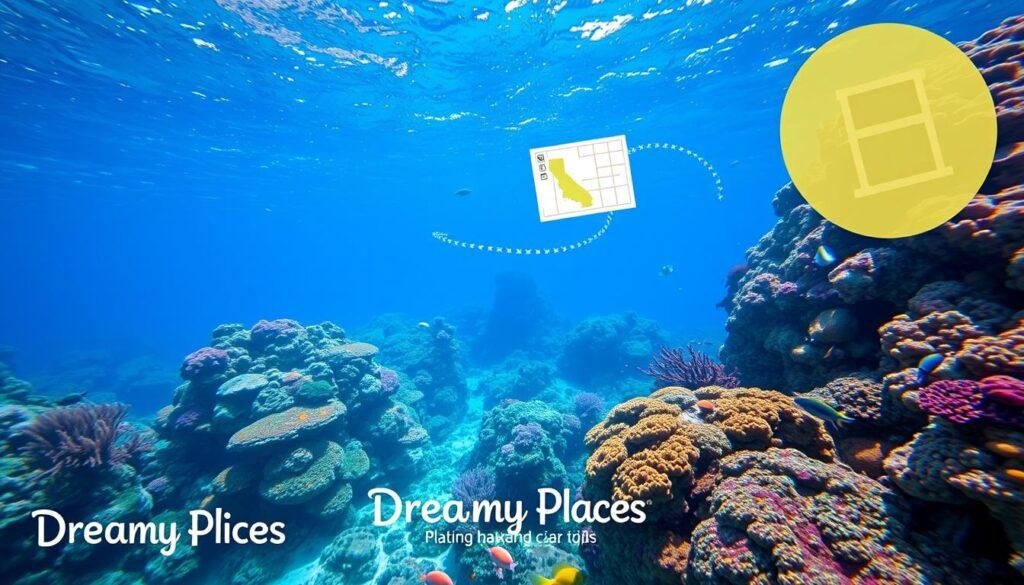
Knowing the weather, marine hazards, and emergency procedures helps you explore the great barrier reef safely. With the right preparation, you’ll have an unforgettable and awe-inspiring experience.
Must-Visit Reef Locations and Islands
Exploring the Great Barrier Reef is an adventure. You’ll find amazing spots like the Outer Great Barrier Reef, Lady Elliot Island, and Whitsunday Islands. Each place offers a unique experience you won’t forget.
The Outer Great Barrier Reef is a sight to behold. It’s full of vibrant marine life. You can see colorful corals, tropical fish, and even manta rays or sea turtles.
Lady Elliot Island is a hidden treasure. It’s famous for its clear waters and marine life. You can see humpback whales and rare species like manta rays and hawksbill turtles.
The Whitsunday Islands are a mix of beauty and peace. With 74 islands, you can enjoy white-sand beaches, turquoise waters, and lush rainforests. It’s perfect for boat trips, hiking, or just relaxing on the beach.
Visiting these top activities in great barrier reef spots lets you dive into the reef’s world. You’ll see the beauty and wonder of this natural wonder up close.
| Destination | Key Features | Activities |
|---|---|---|
| Outer Great Barrier Reef | Remote, pristine, diverse marine life | Snorkeling, diving, wildlife viewing |
| Lady Elliot Island | Eco-resort, crystal-clear waters, rare species | Snorkeling, diving, whale watching |
| Whitsunday Islands | White-sand beaches, turquoise waters, diverse ecosystems | Boat tours, island exploration, beach relaxation |
“The Great Barrier Reef is one of the most breathtakingly beautiful places on Earth. It’s a natural wonder that should be on everyone’s bucket list.”
Photography Tips for Underwater Adventures
Capturing the mesmerizing marine life and vibrant colors of the great barrier reef is exciting. It’s a chance to take stunning photos. Whether you’re new or experienced, learning underwater photography is key. We’ll share the best camera gear and techniques for your great barrier reef travel guide.
Best Camera Equipment for Reef Photography
The right camera equipment is crucial for exploring great barrier reef. Choose a waterproof or underwater-specific camera. These are made for the marine environment. Or, use a DSLR with an underwater housing to keep it dry.
- Look for features like high-resolution sensors, fast autofocus, and advanced image stabilization to capture sharp, detailed shots of marine life.
- Pair your camera with a wide-angle lens to capture the vast scale of the reef, as well as a macro lens for close-up shots of smaller creatures.
- Don’t forget to pack additional batteries, memory cards, and a reliable underwater light source to ensure you’re prepared for your underwater adventures.
Techniques for Capturing Marine Life
Underwater photography needs special skills and techniques. First, practice buoyancy control to move smoothly. Adjust your camera’s settings for the changing light underwater.
“The key to stunning great barrier reef photography is patience, perseverance, and a keen eye for detail. By honing your techniques and embracing the underwater world, you can capture breathtaking images that will forever immortalize your great barrier reef travel guide experience.”
Try different angles and compositions for interesting shots. Look for schools of fish, colorful corals, and unique behaviors. With practice and curiosity, you’ll capture the great barrier reef‘s magic.
Budget Planning and Cost Considerations
Many dream of exploring the Great Barrier Reef in Travel Australia. But, it’s key to plan your budget well. Costs include transportation, accommodation, tours, and equipment rentals. We’ll outline typical expenses and offer budget tips for enjoying the great barrier reef travel guide.
Transportation to the Reef
Reaching the Great Barrier Reef can be pricey, especially from far away. Domestic flights in Australia cost between $100 and $300, based on where you start and the time of year. You’ll also need to consider ground transport, like buses or cars, to get to your destination near the reef.
Accommodations Near the Reef
Accommodation prices vary a lot. You can find hostels for $50 a night or resorts for $300. It depends on the location, what’s included, and how comfortable you want to be.
Reef Tours and Activities
The great barrier reef travel guide highlights snorkeling, diving, and boat tours. Prices vary from $50 to $200 per person, based on the tour’s length, what’s included, and the operator.
Gear and Equipment Rentals
If you don’t have your own snorkeling or diving gear, you’ll need to rent it. Basic gear costs around $20 to $50 a day. Better gear costs more.
To save money, book early for discounts on accommodations and tours. Look for deals that include several activities at a lower price. With smart planning, you can see the Great Barrier Reef without spending too much.
Conclusion
As your journey to the Great Barrier Reef comes to an end, think about the amazing experiences you’ve had. This natural wonder has amazed visitors for years. Your first visit has surely made a lasting impression on your travel memories.
The Great Barrier Reef shows the stunning beauty and delicate nature of our world. By choosing responsible tourism and supporting conservation, you help protect this iconic place. You’ve seen the diverse marine life and explored the vibrant reef zones, enriching your time in Australia.
Reflecting on your Great Barrier Reef adventure, you’ll find inspiration in its resilience. Let the lessons from your travels guide you in your future explorations. The Great Barrier Reef is waiting for you, ready to share new wonders and unforgettable experiences.
FAQ
What kind of marine life can I expect to see in the Great Barrier Reef?
The Great Barrier Reef is full of amazing marine life. You’ll see colorful fish, sea turtles, and even sharks. There’s also a chance to see humpback whales.
Each reef zone has its own special species. It’s a truly unique place to explore.
What are some tips for responsible tourism at the Great Barrier Reef?
To protect the reef, follow safety rules and don’t touch the coral. Dispose of waste properly and choose eco-friendly tours. This helps keep the reef beautiful for everyone.
Be mindful of your impact. Try to reduce your carbon footprint while visiting.
When is the best time of year to visit the Great Barrier Reef?
You can visit the Great Barrier Reef any time of year. The dry season, from May to October, is best for calm seas and clear views. You might see whales during this time.
The wet season, from November to April, is greener and more vibrant. It’s great for spotting marine life.
How do I get to the Great Barrier Reef?
The Great Barrier Reef is off Australia’s northeast coast. The closest cities are Cairns and Townsville. Fly into one of these cities and then take a boat or helicopter to the reef.
Many tour operators offer packages that include transport.
What kind of snorkeling and diving gear do I need for the Great Barrier Reef?
For snorkeling, you’ll need a mask, snorkel, and fins. Many tours provide these. For diving, you need scuba gear like a wetsuit and regulator.
If you’re new to diving, sign up for a beginner course. Your tour provider can help.
How do I choose the right tour operator for the Great Barrier Reef?
Look for tour operators that focus on sustainability and safety. Consider the group size, activities, and guide qualifications. Read reviews to see what others say.
This helps you choose a quality tour.
What should I do in case of emergencies or bad weather during my Great Barrier Reef visit?
In emergencies or bad weather, follow your guides and local authorities. They know how to keep you safe. Tell your tour operator about any health concerns before you go.
Know the emergency procedures and contact info from your tour company.
What are some must-visit locations and islands within the Great Barrier Reef?
Don’t miss the Outer Great Barrier Reef for its vibrant coral and marine life. The Whitsunday Islands offer stunning beaches and clear waters. Lady Elliot Island is great for snorkeling and diving.
How can I capture great underwater photos during my Great Barrier Reef adventure?
Use a waterproof camera or underwater housing for your camera. Learn about lighting, composition, and positioning to capture the reef’s beauty. Many tours offer photography workshops.
This will help you take amazing underwater photos.
What kind of budget should I plan for when visiting the Great Barrier Reef?
The cost of visiting the Great Barrier Reef varies. It depends on your travel style and activities. Budget for flights, transport, accommodation, and reef tours.
Prices range from budget-friendly to luxury. Plan your trip to fit your budget and comfort level.



